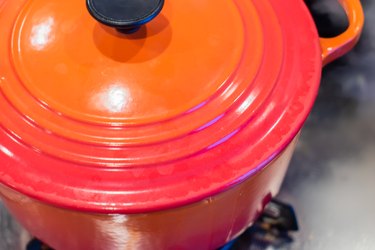
Walk in to any kitchen supply store, and the shine from all the glistening pots and pans may make you reach for your sunglasses. Your senses are immediately assaulted: all the cookware claims to be the newest and best thing to hit the market.
No-stick, non-stick, stick-resistant, a little stick — who can you believe, and how can you determine what shiny or brightly colored saucepan is the right one for you? Two terms jousting for the title of "best cookware" are hard anodized and hard enamel cookware made of porcelain. Distinguishing between the two isn't difficult if you know how to wend your way through the language of surfaces on pots and pans.
Video of the Day
Video of the Day
Building a Better Model
Realizing the weaknesses in aluminum cookware, but aiming to maintain the high conductivity of the element, scientists at Calphalon created hard-anodized aluminum cookware in the 1960s. Through an electro-chemical process, they fused the aluminum in an acid bath jolted with an electrical current, resulting in an oxide blend that had greater resistance than the original aluminum. The process also created a lovely gray coloring, and the scientists noticed that food was less apt to stick than with the original aluminum.
Porcelain Hard Enamel Cookware
Porcelain, a combination of kaolin clay and glass fired at extremely high temperatures, was first fired onto iron in the 1800s, creating a pot lining that eliminated the leaching of iron into food. Through the years, aluminum and stainless steel have also been fused with porcelain, making a hard porcelain enamel product that adds to the myriad of cookware choices.
Benefits of Hard-Anodized Cookware
Touch a hard-anodized pot to realize its strength. The smooth cooking surface is stick-resistant, and its solid surface won't corrode, leach or suffer abrasions. If satellites in the sky can depend on the strength of hard-anodized parts to protect them from the rigors of space, then a mere saucepan is sure to have a long life. Hard-anodized cookware also has excellent heat conduction and cleans safely.
Hard-anodized saucepans are safe at high temperatures, making them ideal for stovetop-to-oven cooking. Just be sure to use potholders when removing the cookware from the oven.
Porcelain Enamel Pros
The high-temperature firing of porcelain onto iron has driven the cookware market for over a century. The process was then expanded to include stainless steel and aluminum. The porcelain isn't a coating over a base metal, but a fusion of the two. The rock-hard surface is resistant to scratching and peeling. While aluminum and stainless steel porcelain enamels are lighter second cousins to cast iron in the realm of cookware, it's the heft of the iron that gives porcelain enamel its edge with serious cooks. Aluminum porcelain enamel doesn't leach, making it a safer choice than unfused aluminum.
Disadvantages of Porcelain Enamel Cookware
Disadvantages of porcelain enamel cookware include the enamel color turning darker with heavy use. This, however, does not affect the cooking qualities of the pot; instead, it simply indicates years of use.
A Sticky Subject
Hard anodization of aluminum not only creates a smooth surface; the result of the fusion process is that the base aluminum becomes non-porous. Food adheres when first put into the pan, but as it nears doneness, it's released from its bond. Hard-anodized cookware is stick-resistant.
Porcelain enamel over iron, aluminum or stainless steel is non-stick. Bits may be left behind, especially during high-heat cooking, but they scrape off with little effort. A good soak in warm water rinses away any residue without effort.
Safe Cooking Considerations
Both hard-anodized aluminum cookware and porcelain-fused enamel are considered safe. The biggest concern is leaching from the base metal to the food, and if chips in the porcelain are avoided, they are not dangerous. The FDA's Center for Food Safety and Applied Nutrition has deemed enamel-coated cookware safe, including products that are imported.
A Beauty Contest
Hard-anodized aluminum cookware is one color: gray. That's the result of the oxidation that takes place during the chemical fusion process. Porcelain enamel over a base metal are manufactured in a riot of colors, which makes them ideal additions to well-decorated kitchens. Many cooks tend to collect porcelain enamel cookware in one color and display them as accessories instead of hiding them in cupboards.